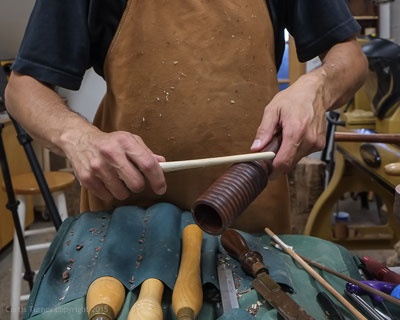Making a Guiro
by Curtis Turner
Round Rock, TX
Note: Click on any picture to see a larger version.
Inspiration strikes again! Inspiration is a funny thing. It is rather unpredictable and uncontrollable. For
some reason, I had the need to make another guiro. Yes, I made one years ago and no, I did not wear
out the old one. I am not a musician and I have never played anything more challenging than a kazoo.
I know you all have been eager to make your own guiro so let's get started.
First, What is a Guiro?
Wikipedia defines a Guiro as "a Latin-American percussion
instrument consisting of an open-ended, hollow gourd with parallel notches cut in one side. It is played
by rubbing a stick or tines along the notches to produce a ratchet-like sound. Playing the guiro usually requires both long and short sounds, made by scraping up and down in long or
short strokes."
Stock Selection
I do not stock gourds in my inventory, so I opted for wood. I selected a blank of Walnut 2" square.
I first marked the blank to find the center. This blank was less than a perfect square as you can see from
the photo:
I then turned the blank to round and used a set of dividers to layout 1/4" beads.
Next, I used a pencil to mark the complete bead and then used the long point of a skew to define each bead.
Beads
A
1/4" Beading Tool
would be a good option for turning the beads. However, I do not own a
1/4" Beading Tool. I opted to use a Small Spindle Gouge. This is where you need to
take your time because rushing here will risk a catch requiring you to start over.
Handle
Once I completed the beads, I began to rough shape the handle. I wanted to drill out the blank before I
completed shaping the handle. The oversized handle provided more support during the drilling
operation.
Drilling
I used a
Drill Chuck
to drill a 35mm hole about 5" deep into the end grain. It
would be possible to use hollowing tools instead of drilling. If you do, keep in mind you will be
extending the tool 4" or more over the tool rest. It becomes difficult to control small hollowing tools
that far over the tool rest.
Refining the Handle
Once the drilling was complete, I was ready to tackle the handle. I mounted the cone center on the live
center and carefully applied just enough pressure to provide support.
I wanted to avoid splitting the walnut. I turned the handle leaving a good 1/2" or so still connecting the handle to the waste
held in the chuck.
Making the Cut
Next, I needed to address how I would cut the slot in the guiro. The slot is necessary to make the sound
brighter. One option would be to use a v-jig to cradle the guiro and make the cut on a bandsaw.
A second method would be to leave the guiro in the chuck and remount the chuck on a carving stand. A
hand saw could be used to make the slot. However, a carving stand is not something most turners own. Alternatively, I could have figured out a way to clamp the chuck in my bench vise. However, I felt that
would be less stable.
So I chose to remove the guiro from the chuck. But first, I used a plane maker's float to create two flat
spots. The flats could also have been achieved by the use of a chisel or
rasp.
I shaped the flats 180 degrees apart. The plan was to use wooden clamps to grip the flat spots.
Now with the handle nearly complete, I applied
Walnut Oil
before I removed
it from the chuck.
I clamped the turning in the wooden jaws. The clamp was held down by two
Holdfasts. I
first used a backsaw to make most of the cut. Finally, I used a small panel saw to make the cut deeper. This setup worked perfectly.
Finally, I remounted the guiro and completed turning the handle.
Turning the Scraper
The scraper is simply a thin spindle with a handle. This could be any shape. I used hackberry to make a rather
simple form.

|
|
It works!
|
This is the kind of instrument I can master! I just hope it doesn't take 10,000 hours.
Curtis is a former President of
Central Texas Woodturners, a member of the
American Association of Woodturners, and a member of
Fine Woodworkers of Austin. Curtis teaches and demonstrates nationally for Lie-Nielsen Toolworks. He also teaches for TechShop. He owns a studio where he teaches and works. Curtis lives in Central Texas with his wife and four young children. Take a look at his website at
www.curtisturnerstudio.com or visit his
Instagram: tx_planes.
